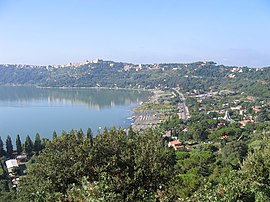Alba Longa
Alba Longa was a legendary and ancient city of Lazio, located in the Alban mountains, founder and head of the Latin League. It was destroyed by Rome around the middle of the 7th century BC. C. There is news of its existence in classical writings, although archaeologically it remains an unlocated site. There are even authors who recently questioned whether it really existed.
Legendary story
According to legend, Alba Longa was founded by Ascanius, also known as Julus, the son of the Trojan hero Aeneas, thirty years after the founding of Lavinium. Chronologically this would have been a generation after the destruction of Troy, which according to Eratosthenes would have occurred in 1184 a. C.
From Ascanio arose a dynasty of kings of which the best known are Procas, and his sons Numitor and Amulius. The power struggle between the two is the framework of the legend of the founding of Rome, since Numitor, deposed by Amulio, is the maternal grandfather of Romulus and Remus.
As a consequence of Rome's rise to power, the two cities came into conflict and finally, under the reign of Tullus Hostilius (mid 7th century BC.), a war between them was resolved by the famous combat between the Horatii and the Curiatii. Legend has it that the three Roman Horacios brothers fought the Curiacios of Alba Longa to determine which people would dominate the other. The last of the Horatii killed the three Curiatii and thus obtained the triumph for Rome.
Alba Longa was destroyed forever and its inhabitants were settled on Mount Caelius as Roman citizens.
Kings of Alba Longa
According to Dionysius of Halicarnassus, the kings of Alba Longa were the direct link between Ascanius and Romulus, the founder of Rome. Tito Livio informs us of the existence of two more kings of Alba Longa, who are not found in Dionysus' list. Both would have reigned during the time of the Roman king Tulo Hostilio. The name of the first of these kings was Gaius Cluilius, who died during a war against the Romans. He was succeeded by Mecio Fufecio, who was executed by Tulo Hostilius for treason.
Archaeological data and historical interpretation
The location of this ancient Latin city has been hotly debated since the 16th century. The starting point is the legend of the founding of Rome by Dionysius of Halicarnassus which speaks of a place between Monte Cavo and Lake Albano. The place has been linked on various occasions to the convent of Saint Paul in Palazzola near Albano, with Coste Caselle next to Marino or, finally, with Castel Gandolfo. In fact, the last of these places occupies the place of Domitian's villa. Ancient sources affirm that the latter had been built in the arx (or citadel) of Alba Longa.
Available archaeological data for the Iron Age show the existence of a string of villages, each with its own necropolis, along the southwestern shore of Lake Albano. When Rome destroyed these towns they must still have been in a pre-urban phase. They would be beginning to cluster around a center that could very well have been Castel Gandolfo, since the necropolis there is significantly larger, suggesting a larger city.
In the late republican period, the territory of Alba Longa (ager Albanus) was populated again with numerous residential villas that are mentioned in ancient literary works and whose ruins have been preserved to the present day.
The Sanctuary of Jupiter Laciar
At the top of the Alban mountains was a very ancient sanctuary consecrated to Jupiter Laciar. Floro (2nd century) points out that the place had been chosen by Ascanio, who, after having founded Alba Longa, invited all the Latins to celebrate sacrifices to Jupiter in that place. The custom that led to the celebration of the feriae Latinae, in which all the cities that belonged to the Latin confederation met under the aegis of Alba Longa and sacrificed a white bull, whose meat was distributed among all participants.
After Alba Longa was destroyed and Rome assumed its leadership, tradition recalls the construction, during the reign of Tarquin the Proud, of a great temple dedicated to Jupiter Laciar in the Alban mountains, of which you can barely see. contemplating today a few vestiges of its walled perimeter. Substantial remains of the paved road that connected the sanctuary to the Via Appia near Aricia have also been preserved.
Contenido relacionado
French Academy of Sciences
Kingdom of Asturias
Laika

